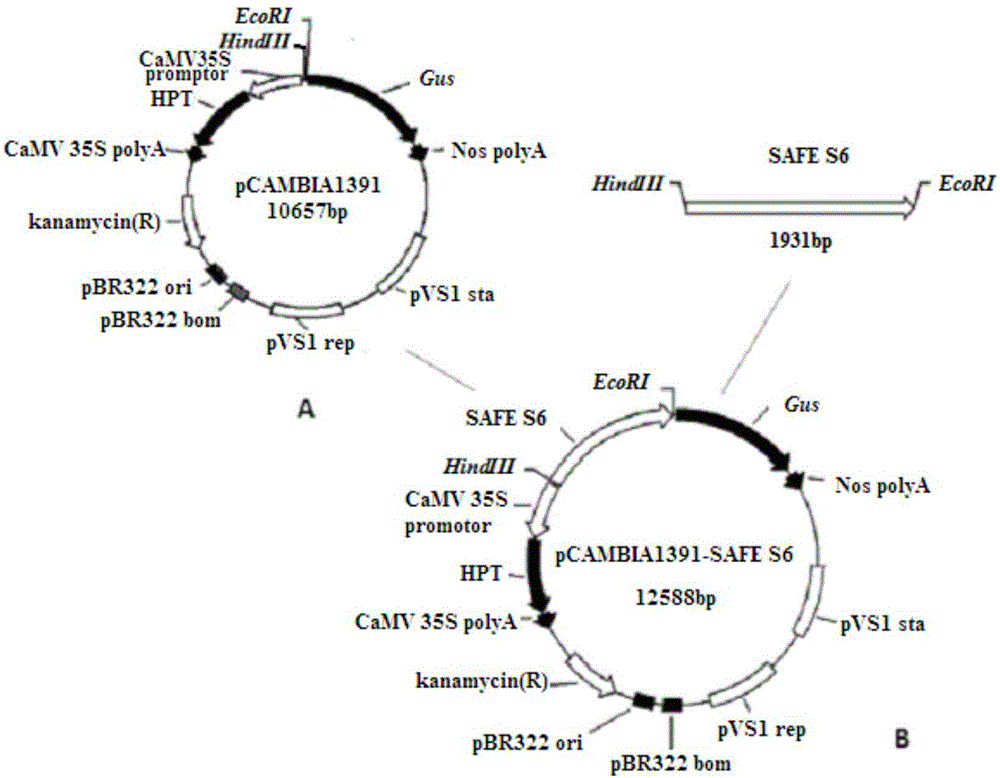Separated non-expressed promoter SAFES6 in endosperm and application of separated non-expressed promoter SAFES6
A promoter and isolated technology, applied in the fields of biotechnology and crop genetic engineering, can solve problems such as research results having no application value and hindering development
- Summary
- Abstract
- Description
- Claims
- Application Information
AI Technical Summary
Problems solved by technology
Method used
Image
Examples
Embodiment 1
[0063] Embodiment 1, the acquisition of SAFES6 promoter
[0064] Step 1. Design of primers
[0065] According to the whole genome sequence of rice variety Nipponbare (Oryza sativa L cv. Nipponbare) provided by NCBI, the amplification primers were designed according to the sequence of the rice promoter SAFES6 (the sequence shown in SEQ ID No: 1 in the sequence table), and according to the selected The characteristics of the vector and the target gene, and the design of the restriction site of the primer. The seeds of the rice variety Nipponbare used in the present invention were obtained from the seed bank of the Rice Research Institute of Anhui Academy of Agricultural Sciences.
[0066] In this embodiment, rice binary expression vector pCAMBIA1391( figure 2 In part A, from CAMBIA, which is a carrier for public use, and is preserved by the rice group of the Supervision, Inspection and Testing Center for GMO Product Components of the Ministry of Agriculture, Anhui Academy of ...
Embodiment 2
[0075] Embodiment 2, the construction of crop expression vector and the transformation of Agrobacterium
[0076] From the Escherichia coli positive clones obtained in the above "acquisition of promoter SAFES6", extract the PGEM-T-Easy vector plasmid containing the promoter SAFES6 fragment, and perform double digestion with HindIII and EcoRI to recover the promoter SAFES6 fragment. At the same time, HindIII and EcoRI were used to digest the crop expression vector pCAMBIA1391, and the pCAMBIA1391 fragment after digestion was recovered. The pCAMBIA1391 vector contains the reporter gene Gus driven by no promoter (the promoter to be studied in the present invention is inserted in the upstream of the Gus gene, for driving the expression of the Gus gene, reflecting the properties of the researched promoter with the expression characteristics of the Gus gene ) The above recovered SAFES6 fragment and pCAMBIA1391 fragment were connected with T4 DNA ligase (purchased from TaKaRa Company)...
Embodiment 3
[0077] Embodiment 3, promoter SAFES6 drives the expression of Gus reporter gene
[0078] Step 1: Agrobacterium-mediated genetic transformation of rice
[0079] After removing the chaff of mature Nipponbare rice seeds, soak the seeds with 70% alcohol for 1 min, and pour off the alcohol. Soak the seeds with a solution of 50% sodium hypochlorite (the concentration of available chlorine in the stock solution is greater than 4%) containing 1 drop of Tween 20 for 40 minutes, and shake them evenly on a shaker (150r / min). Pour off the sodium hypochlorite, wash with sterile water 5 times until the solution is clear, without the smell of sodium hypochlorite. Soak the seeds in sterile water overnight. The embryos were peeled off along the aleurone layer of the seeds with a scalpel, and the embryos were inoculated on callus induction medium. After 11 days of dark culture at 30°C, the callus was separated from the endosperm and germ, and the primary callus in a good state of degerminati...
PUM
 Login to View More
Login to View More Abstract
Description
Claims
Application Information
 Login to View More
Login to View More - R&D
- Intellectual Property
- Life Sciences
- Materials
- Tech Scout
- Unparalleled Data Quality
- Higher Quality Content
- 60% Fewer Hallucinations
Browse by: Latest US Patents, China's latest patents, Technical Efficacy Thesaurus, Application Domain, Technology Topic, Popular Technical Reports.
© 2025 PatSnap. All rights reserved.Legal|Privacy policy|Modern Slavery Act Transparency Statement|Sitemap|About US| Contact US: help@patsnap.com



